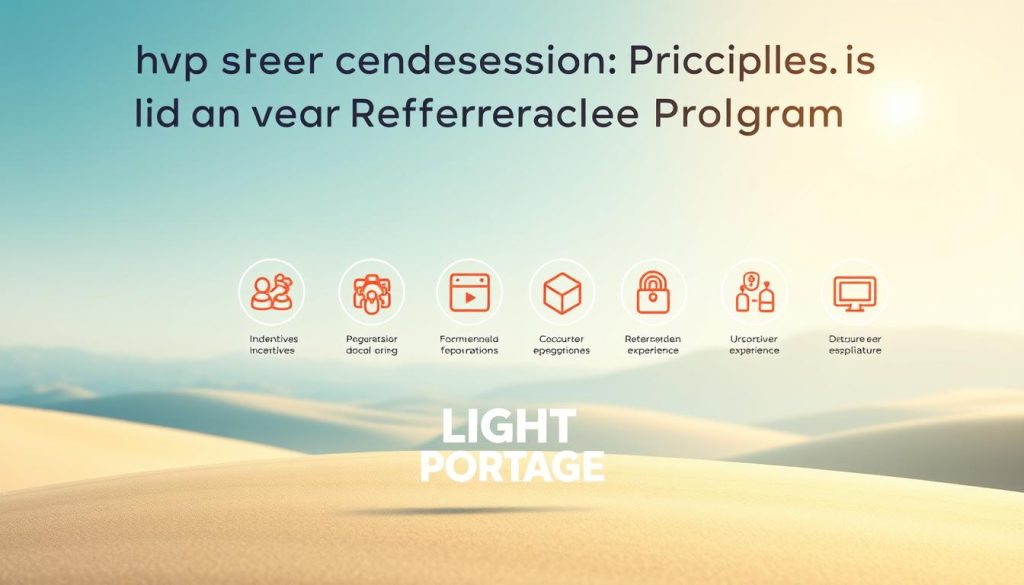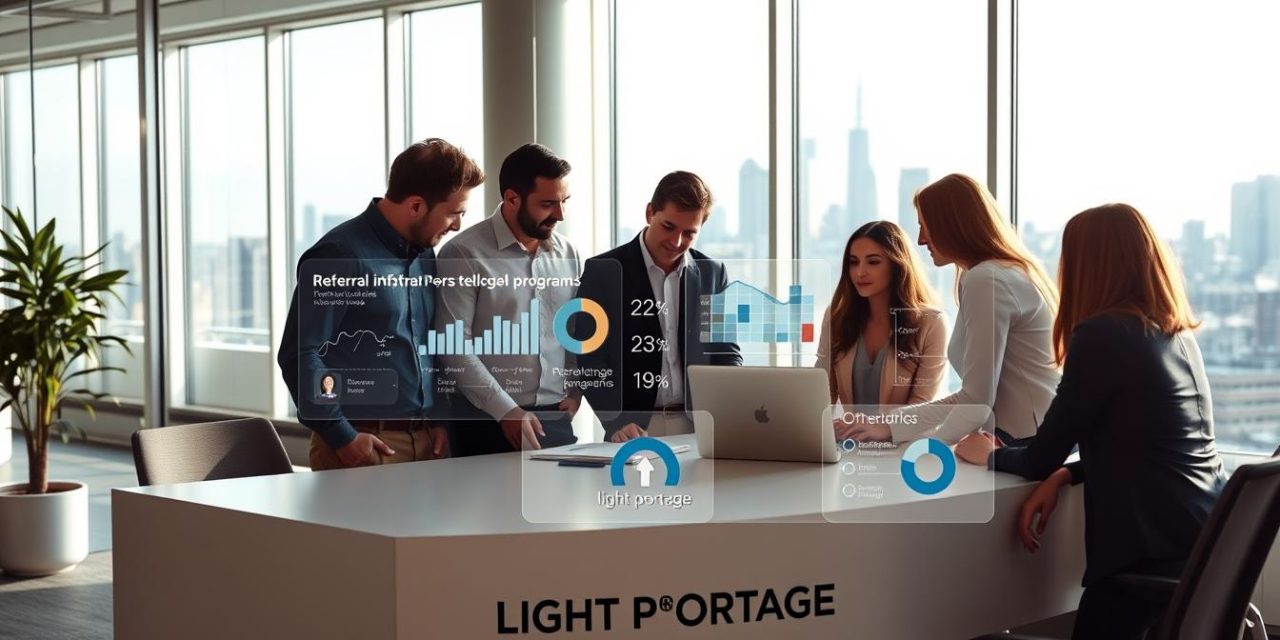We begin with a simple story: a small Parisian startup rewarded a loyal user for recommending a friend. That one recommendation turned into a chain of sign-ups that outpaced paid ads in both cost and trust.
This guide shows how to turn natural advocacy into a structured system of rewards that respects your users and protects your brand. You will find practical steps, clear terms, and real reward figures so you can design a fair system that drives acquisition and retention.
Expect comparisons across business models and vetted examples from SaaS, finance, telecom, and consumer apps. We highlight anti-spam guardrails and activation milestones to make sure rewards unlock only for qualified outcomes.
For a deeper case study and specific numbers from active schemes, see this concise overview on referral marketing examples.
Table of Contents
Key Takeaways
- Design simple, fair rewards and state clear eligibility to build trust.
- Benchmark reward amounts and caps against real-world examples before setting levels.
- Use activation milestones to limit fraud and protect your budget.
- Balance strategic design with tactical steps for quick, responsible rollout.
- Monitor referred cohorts versus paid cohorts for long-term value insights.
Why Referral Marketing Wins Today: Cutting Through the Noise to Earn Trust
When ads blur together, a trusted suggestion from a friend becomes the clearest signal buyers can use.
People trust peers more than paid messages. That trust lowers friction, so customers sign up faster and conversion costs drop. Referred leads often reach key milestones sooner, improving acquisition quality for your business.
Authentic, human-centered messaging outperforms generic promotions. Frame your product with real use cases and outcomes to make sharing natural for users.
Celebrate advocates. Meaningful rewards and public recognition build community and increase retention. When referred customers become referrers, a virtuous loop forms and organic reach grows without heavy spend.
Where to prompt and how to personalize
- Place in-app and website prompts at moments of delight.
- Use targeted email nudges sparingly to avoid fatigue.
- Offer share flows that let users pick the right friend and add a personal note.
| Metric | Typical Impact | Why it works | Example tactic |
|---|---|---|---|
| Conversion speed | Higher | Trust from a friend | One-click invite in-app |
| CPA | Lower | Qualified leads | Dual-sided rewards |
| Viral potential | Compound growth | Advocates become referrers | Recognition and badges |
| Retention | Improved | Community and reward alignment | Milestone celebrations |
Product Roundup Methodology: How We Curated Successful Referral Program Examples
We selected live examples using strict, measurable criteria. Our aim is to give you clear benchmarks so you can design or evaluate your own plan with confidence.
Selection focused on active offers that publish eligibility, verification steps, and easy enrollment for existing customers. Each example must show an in-product link or a single code that lets users invite a friend without friction.
Active status, clear terms, and simple enrollment
Only live initiatives with visible terms made the list. We confirm eligibility windows, refund rules, and the verification path so payouts match genuine conversions.
Reward relevance, dual-sided incentives, and sensible caps
- Aligned rewards: credits, cash, or product benefits tied to the service (Dropbox storage is a good example).
- Dual-sided offers: both referrer and new customer benefit (e.g., Fiverr friend discount).
- Caps and margin protection: clear limits such as $50 per referral up to $500 per year to balance generosity and cost.
| Selection Criterion | What we check | Real-world example |
|---|---|---|
| Active status | Program live and accepting sign-ups | Fiverr discount flow |
| Clear terms | Eligibility, refund window, verification steps | T‑Mobile $50 per referral cap |
| Reward alignment | Benefits match the product or services offered | Dropbox storage per signup |
| Enrollment ease | Single link or code accessible in-product | In-app share link confirmed |
Referral Programs vs. Affiliate Programs: Choosing the Right Growth Engine
Choosing between customer-led sharing and publisher-driven promotion shapes how fast and where your service grows.
Referral approaches engage happy customers to share via social channels and email in easy, personal moments. They typically use credits, discounts, or perks and often limit the number of referrals per client to control cost and abuse.
Affiliate methods recruit creators, bloggers, and publishers to promote on websites and video channels. Compensation is usually cash commissions, often recurring and uncapped, but subject to disclosure rules and publisher compliance.
- Channels: social/email for customers; sites, blogs, and video for affiliates.
- Compensation: credits or discounts vs. cash commissions and percentages.
- Limits & rules: caps and anti-spam for customer sharing; disclosure and tracking for affiliates.
| Use Case | When to Choose | Example |
|---|---|---|
| Activate advocates | Low-cost, trust-led acquisition | GetResponse referral credits |
| Scale reach | New audiences and categories | GetResponse affiliate commissions |
- Diagnostic: if customers love your product and share naturally, prioritize customer-led rewards.
- If you need broad visibility, add affiliate channels and clear disclosure.
- Combine both when you want community trust plus scalable acquisition without channel conflict.
Iconic Example: Dropbox’s “Per Referral” Storage Playbook
Dropbox turned a simple extra-storage reward into a growth engine that fits the product rather than fighting it.
The concept is clear: give useful storage when a friend signs up and verifies their email. Basic accounts earn 500 MB per referral up to 16 GB. Plus accounts earn 1 GB per referral up to 32 GB.
This per referral model aligns value with daily use. Extra storage increases engagement and reduces churn. A single, low-friction invite link speeds sharing and accelerates organic reach.
« Offering more of what users already need made sharing natural and measurable. »
Key mechanics at a glance:
- Dual-sided incentive: both parties gain useful space.
- Email verification prevents abuse and preserves margin.
- Tiered caps protect unit economics while feeling meaningful.
| Metric | Basic | Plus |
|---|---|---|
| Per referral | 500 MB | 1 GB |
| Max extra storage | 16 GB | 32 GB |
| Verification | Email required | Email required |
Takeaway: this example shows how product-aligned storage incentives form viral loops that scale sustainably. The lesson transfers to any service where utility can grow with advocacy.
B2B SaaS Standouts for New Customers and Retention
For many business tools, rewards that grow with headcount encourage larger, stickier accounts.
Google Workspace ties one-time payouts to users. Rewards range from $8 to $23 per user. Caps exist: 100 users per account and 200 users per year. Availability spans 24 countries, so plan regionally.
GetResponse gives $30 in credits to both parties, with an annual cap of $480. After three successful referrals, clients can earn a certification worth about $200—an attractive twist for digital marketing teams.
Hubstaff issues a 10% subscription discount per successful referral for one year. Discounts stack up to 100%, letting customers progressively reduce costs while keeping clear time limits.
Zoho delivers 15% of the referred customer’s subscription fee as wallet credits valid for one year. The referred client also receives a $100 promo. Note: rewards apply only on the first purchase, a common guardrail.
- Caps & windows: annual and per-account limits keep budgets predictable.
- Dual benefits: credits and promos reward both existing clients and new customers.
- Regional notes: check availability—Google Workspace is available in 24 countries.
| Vendor | Incentive | Caps / Validity | Client benefit |
|---|---|---|---|
| Google Workspace | $8–$23 per user | 100 users/account; 200 users/year; 24 countries | Scaled payouts based on account size |
| GetResponse | $30 credits each; certification after 3 | $480 max/year; certification ≈ $200 | Credits + learning credential for marketers |
| Hubstaff | 10% subscription discount per referral | One-year discount; stackable to 100% | Progressive savings on subscription |
| Zoho | 15% wallet credits; $100 promo for new client | Credits valid 1 year; rewards on first purchase only | Immediate benefit for referrer and new customer |
Consumer Favorites: Easy Ways to Refer Friends and Earn
Simple, consumer-friendly offers convert because they match everyday habits and lower friction to try a new service.
Below are clear, actionable examples that make it easy to refer friends and collect tangible rewards. Each case uses a straightforward share link, transparent caps, and dual-sided incentives so customers feel confident when they introduce a friend.
Fiverr
Friends get 10% off (up to $100 per purchase). The referrer earns credits—up to $100 per qualifying purchase and up to $500 total. Note: this excludes Fiverr Business accounts and defines qualified purchases to limit abuse.
Swagbucks
Swagbucks gives you 10% of a referral’s SB earnings for life. There’s also a 300 SB early bonus when the new user earns 300 SB in their first 30 days. That long-term income stream rewards ongoing engagement.
Ibotta
Ibotta pays $10 when a referred friend submits a qualifying first purchase within seven days. The new customer receives a $5 bonus and $10 after the offer clears, encouraging quick activation.
- Why these work: dual rewards, clear caps, and a simple link make sharing natural.
- Adapt these mechanics to consumer services that benefit from a fast trial or first purchase.
Finance and Fintech Programs That Drive High-Value Referrals
When money or credit is involved, clarity and precise timing make sharing trustworthy and legal. Financial offers succeed when rewards feel tangible and verification is strict.
SoFi uses points that convert to cash value to simplify rewards. The referrer receives 2,000 points ($20) and the new user gets 1,000 points ($10).
Key guardrails matter: users must register within 24 hours of clicking the link, and there is a five-referral cap to limit exposure. Multiple SoFi lines (Loan, Invest, Credit Card, Money, Bank) let the brand tailor offers by product while keeping terms clear.
Pawns.app takes a different tack: ongoing payouts. Referrers earn 10% of referred users’ earnings and new signups get an immediate $3 bonus via an affiliate link.
- Points-to-cash framing reduces confusion and raises perceived value.
- Timing rules and annual caps enforce compliance and limit abuse.
- Ongoing commission structures appeal to users who value passive, compounding rewards.
| Brand | Incentive | Key Rules |
|---|---|---|
| SoFi | 2,000 pts ($20) referrer; 1,000 pts ($10) new user | Register within 24 hours; 5 successful referrals cap; multiple product lines |
| Pawns.app | 10% of earnings + $3 signup bonus | Ongoing commission; signup via affiliate link; earnings tracked |
Guidance: communicate responsibly when money is at stake. Make terms visible, set fair caps per year, and verify activation milestones so customers and users trust the offer.
Telecom and Energy: Bigger-Ticket Rewards with Clear Caps

Large incentives need precise milestones so payouts match true business value and reduce gaming.
In telecom and energy, companies pay more because the customer lifetime value is higher and activation takes time. T‑Mobile and Tesla Solar are good examples of how to structure larger rewards while protecting the brand and budget.
T‑Mobile example
T‑Mobile pays $50 per referral, delivered to a Virtual Express Prepaid MasterCard, with a strict $500 per year cap.
- Eligibility: referrer and new customer must meet postpaid requirements.
- Cooling period: the referred account must not have been a customer in the prior 90 days.
- Fulfillment: prepaid card simplifies tracking and reduces fulfillment delays.
Tesla Solar example
Tesla Solar offers larger sums—about $300 per solar panel install and $500 per solar roof—paid only after activation and permission to operate.
- Payouts align with real value: payment after activation ensures quality conversions.
- Anti‑spam rules: public sharing is allowed, but mass distribution or spam voids rewards.
- Verification and compliance are stronger to prevent abuse on high-ticket services.
Takeaway: For any business selling higher-value services, communicate caps, timelines, and eligibility up front. Clear terms preserve trust, simplify operations, and make the offer safer for customers and the company.
| Brand | Per referral reward | Cap / Condition |
|---|---|---|
| T‑Mobile | $50 | $500/year; postpaid eligibility; 90‑day cooling period |
| Tesla Solar | $300–$500 | Paid after activation & permission to operate; anti‑spam rules |
Storage and Productivity Perks: Credits, Discounts, and Extra Space
Product-aligned perks—extra space, credits, or subscription discounts—make sharing feel useful rather than promotional. These offers work when milestones tie rewards to real product use.
SugarSync layers storage bonuses to match plan size and activation steps. New accounts get 500 MB at creation, then a 10 GB bonus when a friend opens a >60 GB plan. The remaining 9.5 GB arrives after qualified install and payment. Total bonuses can reach up to 40 GB, keeping rewards meaningful without overspending.
SugarSync: tiered bonus storage up to 40 GB
Structure: staged delivery (account, install, payment) aligns reward with value and reduces abuse.
FreeAgent: 10% off per active referral with no earning limit
FreeAgent grants a 10% subscription discount to both parties for each active referred account. There is no cap—ten active referrals can offset a whole subscription. Only direct subscribers qualify and discounts end if a referred account cancels.
quip: $5 credits with private sharing policy
quip issues $5 credits to both users for qualifying invites. The offer requires private sharing only; public posts void eligibility. This rule protects brand standards and lowers spam risk.
- Why these work: storage, subscription savings, and small credits fit productivity tools and boost retention.
- Encourage respectful, direct outreach to friends rather than mass public posting.
- Tie rewards to continued usage to keep incentives aligned with long-term value.
Affiliate-Style Hybrids Worth Knowing
Some commercial offers mix direct customer rewards with affiliate-style payouts to scale reach. These hybrids sit between simple in-product sharing and full publisher partnerships. They appeal to creators and active customers who can make high-quality introductions.
Astra is a strong example: it offers up to 50% commission, with ceilings as high as $375 per sale. The setup includes a dedicated dashboard, swipe copy, and promo assets that help you promote ethically and efficiently.
Hostinger blends elements: a 20% commission on qualifying year-long plans and a 20% discount for the friend. Payouts clear after a 45-day validation window and are sent via PayPal or wire transfer. Historical caps have reached $450 in some markets.
- Dashboards and media assets reduce lift for customers who want to promote content responsibly.
- Combine a friend discount with a meaningful commission to raise conversion while protecting margin.
- Write clear terms around payout windows and refund periods to avoid disputes.
| Brand | Commission | Friend benefit | Validation |
|---|---|---|---|
| Astra | Up to 50% / max $375 | — | Dedicated dashboard |
| Hostinger | 20% on 12+ month plans | 20% discount | 45 days; PayPal/Wire |
Takeaway: these hybrid offers let you extend reach beyond immediate networks while still rewarding customers and creators. Keep messaging aligned with terms so trust remains high across a broader audience.
What Makes Successful Referral Programs Stick
Sticky referral efforts stem from clear steps that reward practical use of your product.
Keep flows effortless. Make sharing a single click inside the app or an email template ready to send. Clear, transparent steps reduce hesitation and support faster activation.
Simple flows, dual incentives, and product-aligned rewards
Design rewards that reinforce daily value. Dropbox-style extra storage is a prime example: the reward increases product use and reduces churn.
Dual-sided incentives motivate both the advocate and the new customer. Time-to-reward and easy verification set expectations and cut support calls.
Personalization, advocacy celebration, and viral loops
Personalized messages make people comfortable sharing their name and reputation. Celebrate advocates with thank-you notes, badges, or early access to features.
When new users become advocates, viral loops form naturally. Measure referred cohorts against paid channels to refine rewards over time.
| Trait | Why it matters | Example |
|---|---|---|
| Effortless share | Reduces friction; raises conversion | One-click in-app invite |
| Product-aligned reward | Boosts usage and retention | Extra storage (Dropbox) |
| Dual incentives | Encourages both parties to act | Credits for referrer & newcomer |
| Celebration & status | Creates advocacy beyond cash | Badges, thank-you emails |
Design Principles for High-Conversion referral programs

Start with measurable aims so every mechanic you build ties directly to growth or retention.
Define whether your primary goal is new leads, faster activation, or increased revenue. That decision shapes reward size, verification steps, and reporting.
Define goals, keep it simple, and promote in-product
Keep the flow effortless. Create a single shareable link inside the product and one or two recommended channels (email or website share). Simple paths reduce friction and raise conversion.
Promote the offer at moments of delight—after a successful task, payment, or milestone—so customers share when intent is highest.
Right-size rewards, set fair limits, and prevent abuse
Match rewards to perceived value and margin. Use annual caps (for example, $500 per year) to protect budget and keep offers sustainable.
Embed anti-spam rules and basic verification steps. Make expectations visible: verification timeline, eligibility, and payout windows cut support questions.
- Start with explicit goals: lead volume, activation, or revenue.
- One-click share: link generation and minimal inputs.
- In-product promotion: timed nudges, not mass emails.
- Fair caps & verification: keep rewards meaningful and secure.
- Visible terms: clear steps reduce disputes and build trust.
| Design Area | Best Practice | Example |
|---|---|---|
| Goal alignment | Choose one primary metric to guide design | Activation-focused reward for first purchase |
| Share mechanics | Single in-product link; one or two channels | In-app share to email or website |
| Limits & abuse | Annual cap + anti-spam policy | $500/year cap; Tesla-style public-sharing guardrail |
| Verification & payouts | Simple, transparent milestones and timing | Email verify then payout within 30 days |
Acquisition, Activation, and Reward Timing: Getting the Mechanics Right
Clear timing and simple checks make the path from an invite link to a paid account predictable and fair.
From click to conversion, we map four steps: attribution, qualification, verification, and payout. Each step must be short, visible, and tied to real value so customers trust the process.
From click to conversion: triggers, verification, and payout windows
Start with an attribution link that records source and time. Next, set a qualification milestone such as a verified account or first paid subscription. Examples: Dropbox uses email verification; Ibotta requires a first purchase within seven days.
Choose verification that matches value. Hostinger waits 45 days before payouts; Tesla pays only after activation and permission to operate. Google Workspace enforces per-user caps and regional limits to control exposure.
- Recommend milestones: first paid subscription, verified account setup, or activation event.
- Deadlines: short windows (seven days) drive momentum; longer windows (45 days) allow validation.
- Payouts: specify method—credits, cash, or discounts—and a clear schedule.
| Step | Example | Timing | Why it works |
|---|---|---|---|
| Verification | Dropbox | Email verify | Prevents fake accounts |
| Payout validation | Hostinger | 45 days | Allows chargebacks/refund checks |
| Activation-based reward | Tesla | After activation & permission | Ensures true value delivered |
| Quick activation | Ibotta | First purchase within 7 days | Encourages fast conversion |
Visibility matters: provide a dashboard so advocates can track link status, qualification, and payout ETA. Keep rules simple for customers, but robust enough to prevent misuse across countries and account types.
Measurement That Matters Today
Measure the signals that show whether sharing actually builds long-term value for your customers and business.
Start beyond headline counts. Track conversion, retention, and value to know if referrals create durable growth.
Track referral rate, CPA, LTV, and downstream advocacy
We recommend a focused metrics stack: referral rate, conversion to paying customer, CPA, LTV, and payback period. These figures show unit economics and the true cost per acquisition.
Compare referred vs. paid-acquired cohorts over time
Compare cohorts on retention, expansion, and advocacy to see real impact. Watch how many customers later make referrals—this indicates viral loop strength.
- Monitor reward cost per qualified conversion to calibrate incentives.
- Measure time from click to activation and remove friction points.
- Segment by channel (in-product, website, email) to allocate spend where results are strongest.
- Share results across teams so targets and budgets align and improve year-over-year decisions.
| Metric | What to measure | Why it matters |
|---|---|---|
| Referral rate | % of customers who share | Shows advocacy and growth potential |
| CPA | Cost per qualified conversion | Helps compare against paid channels |
| LTV & payback | Lifetime value and months to recoup cost | Ensures sustainability |
| Downstream advocacy | % of referred who refer others | Measures viral loop health |
Takeaway: use this data to iterate your offer, adjust caps, and refine messaging so the initiative supports long-term acquisition and retention.
Practical Playbook to Launch or Optimize Now
The fastest wins come from a tight stack: link generation, visible dashboards, and consent-first outreach.
Tooling, messaging, and channels
Start by adding a link generator inside the product so customers can share without friction.
Provide a simple dashboard that shows status, qualification, and payout ETA. Offer templated copy for email and social that users can personalize.
Place entry points in the app, the website footer or menu, and timed email campaigns after moments of delight. Use friend discounts or dual-sided rewards so both clients and new users feel the benefit.
Compliance and anti-spam basics for ethical sharing
Define consent-based outreach: require explicit opt-in for email invites and allow easy opt-out. Make terms visible and limit mass distribution tactics that feel like spam.
Document and enforce rules: list prohibited channels, set caps, and mirror examples such as Tesla’s public‑sharing guardrails to protect reputation and margin.
- Set SLAs for payout timing and support so people feel secure.
- Provide creative assets and clear sharing guidance for social posts.
- Pilot, measure, and iterate rewards; scale or right-size incentives when cohort metrics shift.
Operational note: launch a short pilot, track conversions and LTV, then expand the effort where customers drive the best value.
Conclusion
When incentives match product value, sharing becomes a predictable growth lever.
Referral offerings deliver lower-cost acquisition, stronger trust, and compounding advocacy when you pair clear terms with aligned rewards and anti‑spam guardrails.
Best examples—from Dropbox and Google Workspace to T‑Mobile, Tesla Solar, and SoFi—keep flows simple, verify quality, and pay on milestones that reflect true value.
Focus measurement on LTV and downstream advocacy, not just counts. Start lean: pilot a small effort, track cohorts, then scale with fair caps and visible rules.
Conclusion: with clear terms, sensible limits, and steady iteration, you can turn satisfied customers into a durable, trusted acquisition engine for your business.
FAQ
What is the simplest way to start a referral marketing initiative for my freelance or small business?
Begin with a clear goal (new customers or retention), a single attractive reward for both parties, and an easy sharing flow—email link, social share, or copyable code. Integrate tracking early (UTM or referral tokens), publish concise terms, and promote the offer inside your product and via email. This reduces friction and protects your brand while you test acquisition cost and conversion rates.
How do we choose between a referral approach and an affiliate model?
Use a referral-oriented model when you want advocacy from existing clients and simple, dual-sided incentives. Choose affiliate-style for broader publisher reach and higher per-sale payouts. Many businesses combine both: referrals for organic growth and affiliates for wide-reach campaigns. Decide by comparing expected CPA, lifetime value, and the channels your audience uses.
What reward structures tend to perform best across products and services?
Effective rewards are product-aligned and proportional to customer value. Options that work well: account credits or discounts, extra storage or features, and modest cash or gift incentives. Dual-sided rewards—benefit for both referrer and referred—boost conversion. Cap rewards sensibly to control cost and prevent abuse.
How did Dropbox scale successfully with its “per referral” storage model?
Dropbox matched a reward (extra storage) directly to product needs. By offering 500 MB–1 GB per successful referral and capping total gains, they created a tangible, ongoing value tied to usage. The incentive was simple to understand, low-cost at scale, and viral because users needed more storage as they onboarded colleagues and family.
What technical and legal steps should I take before launching?
Implement reliable referral tracking (unique links, cookies, or account tokens), verify conversions with server-side checks, and set payout rules and fraud monitoring. Draft clear terms of use, include privacy compliance, and follow anti-spam regulations. This protects revenue and preserves trust with users and partners.
How can I measure whether referred customers are more valuable than paid-acquired users?
Track key metrics by cohort: referral rate, customer acquisition cost (including rewards), activation rate, retention, and lifetime value (LTV). Compare LTV-to-CPA ratios for referred versus paid channels and monitor downstream advocacy to quantify long-term benefits of organic introductions.
What are common anti-abuse controls to include?
Use identity checks, limit rewards per account, require first purchase or active usage before awarding credits, and flag suspicious IP or device patterns. Set waiting periods and manual review thresholds for high-value payouts. These measures maintain program integrity without adding user friction.
Which channels convert best for sharing: email, social, or in-product prompts?
In-product prompts and email yield the highest intent and conversion because they reach active users. Social sharing broadens reach but often lowers conversion. The strongest approach blends channels: promote in-product, reinforce via email, and offer easy social links for viral reach.
How do B2B SaaS examples like Google Workspace or Hubstaff adapt incentives for account-scale?
B2B vendors tie rewards to account size and usage—user-based credits, percentage discounts, or account-level bonuses. This aligns incentives with enterprise value, encourages team adoption, and keeps costs proportional. They often include tiered rewards and clear activation rules to ensure long-term retention.
Can consumer apps offer both cash and credit rewards effectively?
Yes. Cash appeals to broad audiences, while platform credits increase future engagement. Combining a small cash bonus with product credits can maximize sign-ups and usage. Balance immediate appeal with lifetime value by linking some reward components to first transactions or continued activity.
How do telecom and energy companies structure high-ticket referral payouts responsibly?
They set explicit caps and verification steps—limits per referrer per year, activation checks (service must be installed or paid), and anti-spam clauses. Clear timelines for payouts and documented eligibility prevent abuse and control long-term liability while still motivating significant customer introductions.
What role does personalization play in successful referral flows?
Personalized messages increase trust and click-throughs. Allow users to add a short note, prefill friend names when possible, and tailor reward messaging to segments. Personalization turns a generic ask into a trusted peer-to-peer recommendation, improving conversion without major cost.
What are realistic timing expectations for verifying and paying out rewards?
Typical verification windows range from 7 to 90 days depending on product complexity and fraud risk. Simple consumer purchases often clear in 7–14 days; service activations or subscription trials may require 30–90 days. Communicate timelines clearly to maintain trust.
How can small teams run pilot experiments without heavy tooling?
Start with manual or lightweight systems: unique promo codes, short URLs with UTM tracking, and spreadsheet-based validation. Use transactional emails to distribute codes and monitor conversions. As the model proves out, migrate to referral SaaS solutions for automation and scaling.
Which metrics should we report to leadership after a pilot launch?
Provide referral sign-ups, conversion-to-customer rate, cost per acquisition (including rewards), referred cohort retention and LTV, and net new revenue attributed. Also report fraud incidents, average payout timing, and projected annualized impact if current trends continue.
Are there ethical or compliance concerns when incentivizing shares to family and friends?
Yes. Clearly disclose incentives in messages, avoid misleading claims, and respect privacy preferences. Follow platform policies for promotional sharing and ensure messages are not deceptive. Ethical programs protect brand reputation and sustain long-term advocacy.
How do hybrid affiliate-referral models benefit enterprise growth?
Hybrids combine grassroots advocacy with publisher reach. Affiliates bring external traffic and measurable conversions, while customer referrals supply high-trust leads. Coordinating payouts and tracking across both channels helps optimize spend and leverages complementary strengths.





